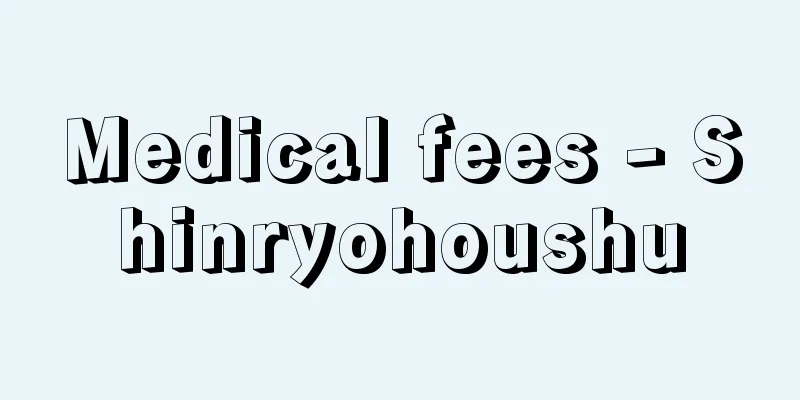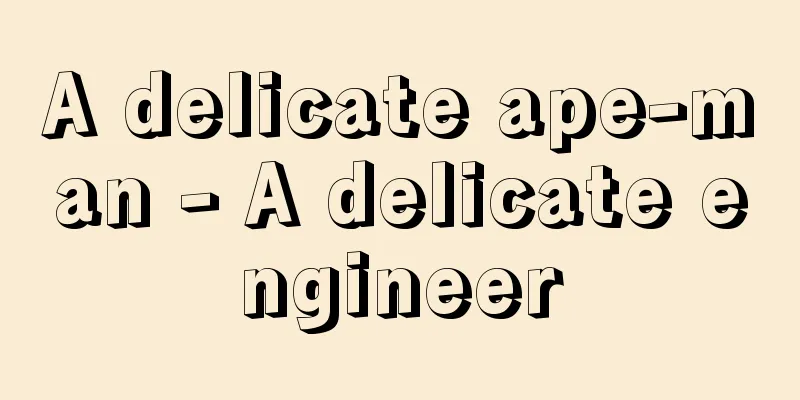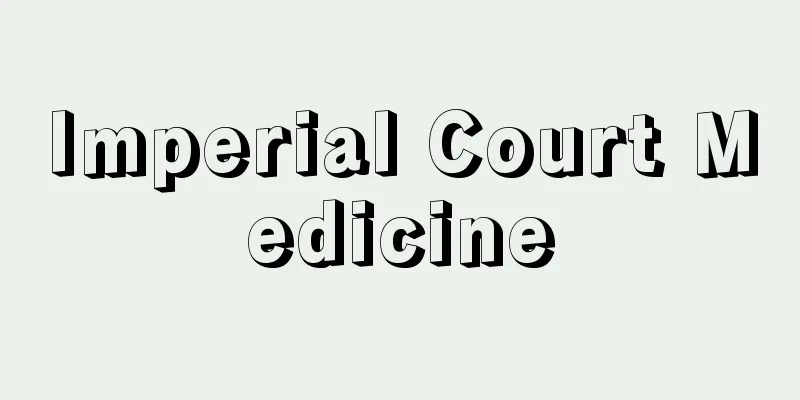Medical fees - Shinryohoushu

|
Remuneration for medical services provided by a clinic, hospital, or pharmacy. Under public health insurance (hereafter referred to as "health insurance"), this refers to the statutory remuneration paid by the insurer to a hospital, clinic, pharmacy, or other insured medical institution in return for providing insured medical treatment (diagnosis, examination, medication, etc.). This medical fee is generally divided into an evaluation of medical technology/service (also referred to as the medical fee itself) and an evaluation of goods (which are determined by the drug price standard for pharmaceuticals and the material price standard for medical materials. Hereinafter, both are collectively referred to as "drug prices, etc."). In addition, medical fees have the "characteristic of a list of items" that determines the scope and content of insured medical treatment, and the "characteristic of a price list" that determines the prices of individual medical procedures or a certain range of medical procedures. [Takeshi Tsuchida October 16, 2020] HistoryDuring the era of private medical treatment before the establishment of medical insurance, medical fees evolved from being a personal payment from the patient to the doctor to gradually forming customary fees (minimum fees are often set by medical associations, etc.) based on factors such as region, medical specialty, and the doctor's experience and qualifications. In Japan, with the enforcement of the Health Insurance Act in 1927 (Showa 2), medical fees were stipulated as official fees, and the capitation contract system was adopted in the medical fee contract between the government and the Japan Medical Association for government-managed health insurance. This means that the government pays the total medical fee (annual amount) based on the number of insured persons to the Japan Medical Association in a lump sum, and the Japan Medical Association distributes it to each prefectural medical association, and each medical association creates a medical fee table that points the content of medical treatment and the amount of work, and pays each doctor according to the work points. In union-managed health insurance, health insurance associations individually concluded medical fee contracts with medical associations on a capitation contract system, a flat-rate system, a current price system, etc. In 1943, under the wartime system, the capitation contract system was abolished, and the Minister of Health and Welfare (currently the Minister of Health, Labor and Welfare) was made to determine medical fees after hearing the opinions of medical associations and others, and a flat-rate unit price system was introduced that set prices for each medical procedure. After the Second World War, in an effort to rebuild the health insurance system, which had fallen into a state of nominal extinction, the Social Insurance Medical Fee Payment Fund was established in 1948 (Showa 23) to facilitate the review and payment of medical fees, and in 1950, the Central Social Insurance Medical Council (Chuikyo) was established as an advisory body to the Minister of Health and Welfare regarding medical fees, with the aim of expanding the scope of insured medical treatment and raising fees. Furthermore, in 1958, a new medical fee system was introduced, which forms the basis of the current medical fee system, setting the unit price at 10 yen per point and amending medical fees by changing the points for each medical procedure while keeping the unit price at a fixed level. Initially, two fee schedules were created: Schedule A (mainly used by hospitals) which emphasized medical technology, and Schedule B (mainly used by clinics) which followed the traditional method, but these were combined into a single fee schedule in the 1994 (Heisei 6) medical fee revision. Initially, medical fee revisions were sometimes made several times a year, but since the 1990s, revisions every two years have become the norm. Since the mid-1990s, as medical expenses have risen against the backdrop of the aging of society, rising consultation rates, and advances in medical technology, calls for reform of the medical fee system, along with reform of the elderly medical system and medical delivery system, have grown stronger in order to provide medical care suited to an aging society and curb the increase in medical expenses. There has also been a growing recognition that medical fees do not simply determine the level of medical expenses, but also have a strong influence on the provision and use of medical services, and reform of the medical fee system has been called for in this direction as well. Against this backdrop, reform of the medical fee system began with the revision of medical fees in fiscal year 2002 (Heisei 14), and in 2003, the comprehensive medical fee payment system by diagnosis group classification (see below for details), was introduced, and in the revision of fiscal year 2004, reforms were made to medical fees for convalescent beds, rehabilitation, etc. In 2004, a bribery scandal involving the Japan Dental Association was uncovered within the Chuikyo, leading to the arrest of Chuikyo members, and in 2005 the Chuikyo's composition and term of office, as well as the nature of medical fee revisions, were drastically revised (see below for details). With regard to medical fee revisions, the Cabinet decides on the revision rate during the budget formulation process, the Social Security Council's Health Insurance Committee and Medical Care Committee decide on the basic revision policy, and Chuikyo sets medical fee points in line with these revision rates and basic policies. As a result, Chuikyo lost its power to decide on medical fee revision rates, and the wishes of the Ministry of Health, Labor and Welfare and the Ministry of Finance came to be strongly reflected. After the Chuikyo reform, the Cabinet announced the largest reduction in medical fees in history in 2006 as part of financial reform, with medical fees reduced by 1.36% and the overall reduction rate including drug prices reduced by 3.16%. The revision included the creation of a "7:1 basic inpatient fee" (one nurse for every seven patients on average during the day and night) to allocate nurses in line with the actual situation of acute medical care, the establishment of a "home care support clinic" system that provides 24-hour house calls and visiting nurses from the perspective of promoting differentiation and collaboration of medical functions, a system of gradually decreasing rehabilitation fees by disease, and the introduction of a comprehensive evaluation system for chronic care beds. In addition to the large reduction in medical fees, a new internship system was introduced, which led to the closure of local hospitals and a shortage of doctors and nurses in 2006, which could be called the collapse of the medical system. This became a major social issue and the Chuikyo was forced to respond. In the 2008 revision of medical fees, the reduction of the burden on hospital doctors, especially in obstetrics and pediatrics, which had become a serious problem, became a major issue, and measures were taken such as raising the high-risk delivery management surcharge, raising the evaluation of pediatric inpatient care and outpatient care, and introducing medical clerks (staff who assist doctors in administrative tasks). In addition, to address the nursing shortage problem that became apparent due to the increase in medical institutions that introduced the 7:1 inpatient basic fee, the 10:1 inpatient basic fee was raised and a measurement standard for nursing necessity was introduced. In addition, the disease-specific rehabilitation fee reduction system, which was criticized for causing rehabilitation refugees, was abolished and a new rehabilitation fee for cerebrovascular diseases was established. In the 2010 revision, the overall revision rate of medical fees was raised to +0.19%, the first increase in 10 years (medical fees themselves were +1.55%). The revision focused on reducing the burden on hospital doctors, reconstructing medical care in emergency medicine, obstetrics, pediatrics, etc., and differentiating functions and strengthening cooperation with nursing care insurance. In the 2012 revision, taking into account the fact that it was a simultaneous revision of nursing care fees, efforts were made to reduce the burden on medical professionals, differentiate and coordinate the functions of medical care and nursing care, improve home medical care, and prioritize allocation to cancer and dementia, etc. The revision rate of the medical care fee itself was +1.38%, and the overall revision rate was +0.004%. In the medical and nursing care sector reforms carried out following the report of the National Conference on Social Security System Reform in 2013, the functional differentiation of medical institutions, including inpatient and outpatient care, and the strengthening of mutual cooperation, as well as the enhancement of home medical care, were promoted in order to build a comprehensive community care system, and the revision of medical care fees was also made to respond to these policies. Specifically, the functional differentiation of hospitals corresponding to acute, subacute, and chronic phases, and mutual cooperation, the enhancement of the function of the attending physician, securing medical institutions that can handle home medical care, and the promotion of cooperation between medical care and nursing care were mentioned. The overall revision rate of medical care fees for fiscal 2014 was set at +0.10% (medical care fees themselves were +0.73%, drug prices, etc. were -0.63%), but compensation measures were taken to cover the increase in taxable procurement costs of medical institutions, etc., due to the increase in the consumption tax rate from 5% to 8% in April 2014, so after deducting this compensation, the actual revision rate was -1.26%. The 2016 revision was made in line with the Basic Policy for Economic and Fiscal Management and Reform 2015, with the aim of keeping the overall growth of social security within the range of the increase in costs due to aging. The revision rate of the medical fee itself was lower than the previous revision, at +0.49%, and the overall revision rate was -0.84%. It was said that the "special reduction in market expansion recalculation" (see the "Drug Price Standards" section for details) of the prices of the hepatitis C treatment drugs sovosbuvir (brand name "Sovaldi") and ledipasvir (brand name "Harvoni"), which have huge annual sales, and similar drugs, contributed to cost reduction in line with the Basic Policy for Economic and Fiscal Management and Reform 2015. In addition, in December 2016, the Central Social Insurance Medical Council formulated the "Basic Policy for Fundamental Reform of the Drug Price System," citing concerns that the current drug price system is not flexible enough to deal with the emergence of innovative and very expensive drugs, and the impact on the public burden and the medical insurance system. As a result, in addition to the drug price survey currently conducted every two years, a survey will be conducted in the intervening year targeting major businesses to investigate drug prices for items with large price discrepancies. The 2018 revision was made at the same time as the once-every-six-year revision of nursing care fees and disability welfare service fees. With regard to medical care fees, differentiation and collaboration of medical functions was deemed the most important issue, and efforts were made to improve home medical care and nursing, strengthen the remuneration system according to the performance of inpatient medical care, expand consultation fees without a referral letter at large hospitals, and promote the use of generic drugs. The revision rate for the medical care fee itself was +0.55%, while drug prices etc. were -1.74%, resulting in an overall revision rate of -1.19%. With the consumption tax rate being raised to 10% in October 2019 (Reiwa 1), the reforms in response to the report of the National Council for Social Security System Reform were deemed complete. Looking ahead to the medical insurance system around 2040, when the number of elderly people will be at its highest, important issues were identified as responding to the growing and diversifying needs for medical and nursing care, improving the productivity of medical and nursing care services, and at the same time securing human resources in the medical and nursing care fields, including doctors. At the time, work style reform in a society with a declining population and an aging population was raised as a major policy issue, and in the medical field, issues such as correcting long working hours for doctors, improving productivity, and utilizing ICT (information and communication technology) were raised. In response to these trends, the basic policies of the 2020 medical fee revision were (1) reducing the burden on medical professionals and promoting work style reform for doctors and others (reducing long working hours, strengthening the emergency medical system, utilizing ITC, etc.), (2) realizing high-quality medical care that is familiar and reassuring for patients and the public (strengthening the family doctor function, strengthening the information provision and consultation function for patients, etc.), (3) differentiating and strengthening medical functions, promoting cooperation and the promotion of a comprehensive community care system (strengthening outpatient functions, home medical care/visiting care, inpatient medical care according to the patient's condition, etc.), and (4) improving the stability and sustainability of the system through efficiency and optimization (promoting the use of generic drugs and biosimilars, promoting cost-effectiveness evaluation, promoting the appropriate use of medicines, etc.). The revision rate was +0.55% for the medical fee itself, of which 0.08% was subsidy for work style reform for doctors working at emergency hospitals using consumption tax revenue. Drug prices, etc. were -1.01%. [Takeshi Tsuchida October 16, 2020] Payment MethodThere are three main payment methods for medical fees: fee-for-service, lump-sum payment, and contract payment. Fee-for-service is a method (point-based payment method) in which points are set for each medical procedure, and medical fees are calculated by multiplying the total of these points by the unit price of one point. While this method has the advantage of providing detailed support for medical procedures and encouraging active medical practice by increasing the economic incentives of doctors, it also has some disadvantages, such as not reflecting differences in the skills of doctors or the services of medical institutions, being prone to excessive testing, medication, or long-term hospitalization, and being complicated in billing, screening, and payment procedures. The lump-sum payment system is a system that comprehensively evaluates a certain range of medical procedures, and the representative types are the per case payment system and the per day payment system. The per case payment system pays a fixed amount for the same disease group from admission to discharge, and this grouping is generally done using the diagnosis related group (DRG), which classifies patients by a combination of the name of the disease and the medical procedure. The representative DRG system is the American system, but it is implemented as DRG/PPS by combining it with the prospective payment system (PPS), which prepays medical fees when a diagnosis group is specified. This system has a large effect of suppressing medical expenses because profits increase when treatment is completed at a lower cost than the medical fees obtained, but there is a risk of poor diagnosis and treatment because it motivates patients to shorten the length of hospital stay and minimize tests and medicines. The per diem payment system is a system in which individual medical procedures are paid for at a fixed daily rate. In Japan, this system has been introduced for acute care beds and long-term care beds. On a daily basis, this system has the effect of reducing medical input, but it has been pointed out that it provides little incentive to shorten hospital stays. The typical contract payment system is where residents register a specific doctor or clinic as their family doctor, and the government or insurer pays the doctor or clinic according to the number of registered patients, and when residents get sick, the family doctor treats them free of charge. This system is also called the capitation payment system. The National Health Service (NHS) in the UK is a typical example. In Germany, for medical fees excluding inpatient care, the health fund that manages the total insurance premiums and federal subsidies pays the total medical fees calculated for each state insurer based on the insured's gender, age, and illness, etc., to the insurer association of each state (total contract payment system), and the insurer association pays the medical fees of each doctor on a fee-for-service basis. Inpatient care in European countries generally adopts the DRG system. In Japan, the fee-for-service system has been the norm since the end of the Second World War, but in 2003, a trial of a diagnosis-based, comprehensive payment system based on diagnosis-based classification (DPC/PDPS: Diagnosis Procedure Combination/Per Diem Payment System, commonly referred to as DPC) was implemented for acute inpatient care at university hospitals and other specialized hospitals. This system was developed in Japan, and determines the daily unit price for each diagnosis group for hospital fees such as basic hospitalization fees, examinations, diagnostic imaging, medication, and simple procedures, and calculates the cost by multiplying the daily unit price by the number of days of hospitalization and a coefficient for each hospital (doctor's fee-based medical procedures such as surgery, anesthesia, and radiation therapy are calculated using the fee-for-service system). The daily unit price varies depending on the number of days of hospitalization, and there is an incentive to shorten the length of hospitalization. In fact, the number of days of hospitalization has decreased, but the effect of reducing medical costs by shortening the number of days of hospitalization is not great. Rather, many believe that the introduction of DPC is meaningful in promoting the transparency of medical care and the standardization of medical information, and in utilizing the accumulated medical information to contribute to the standardization of medical care and the establishment of regional medical care. The number of hospitals subject to DPC was 82 in fiscal 2003, but has expanded rapidly since then, to 360 hospitals in fiscal 2006, 1,505 hospitals in 2012, and 1,730 hospitals in 2018. The number of hospital beds was approximately 490,000 in fiscal 2018, accounting for more than 80% of hospital beds subject to basic fees for acute general hospitalization, etc. Furthermore, the 2006 medical fee revision introduced a lump-sum payment system for chronic inpatient care. A lump-sum daily assessment is carried out for convalescent beds, combining a classification according to medical need and a classification according to ADL (activities of daily living), with the assessment of those with low medical need being lowered to encourage a shift to nursing care insurance. However, due to an insufficient number of convalescent beds covered by nursing care insurance, patients are being encouraged to move to home care. Other issues facing the medical fee reform include the establishment of functional bed numbers by reviewing the allocation standards for nurses in hospitals, an emphasis on prevention and primary care functions, strengthening responses to lifestyle-related diseases, promoting home medical care, and strengthening the functions of attending physicians. During discussions at the Central Social Insurance Medical Council regarding the revision of medical treatment fees in 2006, the issue of making it mandatory to issue receipts and medical bills (medical treatment fee billing details) to patients was raised, and medical institutions were required to issue receipts. The 2008 revision then made it mandatory to issue medical bills if requested by patients (actual costs could be charged), and the 2010 revision made it mandatory for medical institutions and pharmacies to issue medical bills free of charge. Additionally, the use of cost-effectiveness evaluation began to be considered at Chuikyo around 2010, and in 2012 the "Cost-effectiveness Evaluation Specialist Committee" was established within Chuikyo. Trials began for pharmaceuticals and medical materials in 2016, and consideration was given to fully institutionalizing cost-effectiveness evaluation, but various differing opinions were expressed, and in 2018 it was reported that further discussion was necessary. Chuikyo continued its deliberations, and in 2019 the full-scale implementation of the cost-effectiveness evaluation system began, but in this case, taking into account opinions from researchers, pharmaceutical companies, etc., it was decided that the results of the evaluation would not be used to determine whether or not to reimburse insurance, but would be used to adjust prices after the product is listed in the insurance coverage. As of April 2020, six products are subject to this system. [Takeshi Tsuchida October 16, 2020] Response to COVID-19As the novel coronavirus disease (COVID-19) struck Japan in January 2020 and required urgent action, medical fee adjustments were also made. The main measures taken by the Central Social Insurance Medical Council by the end of May 2020 include the following: (1) In wards where the emergency hospitalization fee, intensive care unit management fee, or high care unit hospitalization management fee is charged, the fee can be doubled for severe COVID-19 patients who require management in an ICU, etc. (this was later increased to three times). (2) Medical insurance can be applied when PCR tests are conducted on those suspected of being COVID-19 patients. (3) Medical insurance can be applied when antigen tests are conducted on those suspected of being COVID-19 patients. (4) For patients with moderate COVID-19, double the points of the emergency medical management surcharge can be added for a maximum of 14 days. (5) In-hospital triage implementation fees can be charged for house calls, etc. that are conducted after taking necessary infection prevention measures. In addition, for patients who were scheduled for regular house calls, a visit may be made at their request due to concerns about COVID-19 infection. (6) As a temporary and exceptional measure, when a diagnosis or prescription is made from the initial consultation via telephone consultation or online consultation using information and communication devices, an initial consultation fee may be charged, and when a medicine is prescribed or the prescription information is sent by fax, etc., a prescription fee, basic dispensing technique fee, and drug fee may be charged. (7) When the number of hospital beds permitted under the Medical Care Act is exceeded due to the admission of patients with COVID-19, etc., there will be no reduction in medical fees. (8) When the number of hospitalized patients, etc. temporarily increases due to the admission of patients with COVID-19, etc., or when a nurse is temporarily unable to work due to childcare or other reasons due to the temporary closure of schools, etc., for the time being, it is no longer necessary to notify a change even if there is a temporary change in the average number of night shift hours per month. In similar cases, even if there are changes in the ratio of nursing staff, etc., for the time being, it is no longer necessary to notify the change. (9) If the patient is admitted to a ward other than the original ward, in principle, the basic hospitalization fee, etc. of the ward to which the patient was actually admitted will be calculated. Furthermore, if the patient is admitted to a location other than a ward, such as a conference room, as long as the necessary medical treatment is being provided, the basic hospitalization fee for the ward to which the patient should have been admitted will be calculated from the basic hospitalization fees notified by the medical institution. In addition, at the Central Social Insurance Medical Council general meeting in July 2020, it was decided that a drug price survey for annual drug price revisions based on the "Basic Policy for Radical Reform of the Drug Price System" compiled in 2016 would be conducted in 2020, but that the drug price revisions for fiscal 2021 would be reconsidered, taking into account the impact of COVID-19. [Takeshi Tsuchida October 16, 2020] "Medical Care and Medical Fees in the 1990s" by Niki Tatchi (1992, Keiso Shobo) ▽ "History of Medical Fees" by Aoyagi Seiichi (1996, Shibunkaku Publishing) ▽ "Medical Fees - Their Structure and the Evaluation of Nursing" 6th Edition by Iwashita Kiyoko, Okumura Motoko, Ishida Masahiro, Nomura Yoko, Kanda Yuji, and Minagawa Takashi (2004, Japan Nursing Association Publishing Company) ▽ "Medical Insurance and Medical Fee Systems" edited by Endo Hisao and Ikegami Naoki (2005, Keiso Shobo) ▽ "Medical Care and Nursing in Japan - History, Structure, and the Direction of Reform" by Ikegami Naoki (2017, Nihon Keizai Shimbun) ▽ "Historical Consideration of Modern Medical Fees - Changing Medical Fees" by Nishiyama Masanori (2019, Social Insurance Research Institute) ▽ "Introduction to Insurance Medical Treatment for Doctors 2020" edited by the Social Insurance Medical Treatment Research Group (2020, Jiho) " ▽ "Interpretation of Medical Fee Tables" (2020, Social Insurance Research Institute) ▽ "History of the Japanese Health Insurance System, 3rd Edition, by Yoshihara Kenji and Wada Masaru (2020, Toyo Keizai Inc.)" [References] | | | |Source: Shogakukan Encyclopedia Nipponica About Encyclopedia Nipponica Information | Legend |
|
診療所や病院または薬局が行った医療サービスに対する報酬。公的医療保険(以下「医療保険」という)のもとでは、病院、診療所、薬局などの保険医療機関が保険診療(診療、検査、投薬など)を行った場合に、その対価として保険者から医療機関に支払われる法定の報酬をいう。この診療報酬は一般に、医療技術・サービスの評価(診療報酬本体ともいう)と物の評価(医薬品は薬価基準、医療材料は材料価格基準で定められる。以下、両者をあわせて「薬価等」という)に区分される。また、診療報酬は、保険診療の範囲・内容を定める「品目表としての性格」と、個々の医療行為または一定範囲の医療行為の価格を定める「価格表としての性格」を有している。 [土田武史 2020年10月16日] 沿革医療保険が成立するまでの自由診療の時代には、診療報酬は患者から医師に対する個人的な謝礼という形から、しだいに地域・診療科・医師の経験や資格等を基準に慣行料金(医師団体などが最低料金を規定する場合が多い)が形成されていった。 日本では1927年(昭和2)に健康保険法が施行されたのに伴って、診療報酬が公定料金として規定されることとなり、政府管掌健康保険では政府と日本医師会の診療報酬契約により人頭請負方式が採用された。これは、政府が被保険者数に基づき診療報酬総額(年額)を日本医師会に一括して支払い、日本医師会はこれを各都道府県医師会に配分し、それぞれの医師会が診療内容と稼働量を点数化した診療報酬点数表を作成して、稼働点数に応じた報酬を各医師に支払うというものである。組合管掌健康保険では、健康保険組合が個別に医師会と人頭請負式、定額式、時価式などによって診療報酬契約を結んだ。1943年に戦時体制のもとで人頭請負方式は廃止され、厚生大臣(現、厚生労働大臣)が医師会などの意見を聴取して診療報酬を定めることとなり、医療行為ごとに価格を定めた定額単価制が導入された。 第二次世界大戦後、名存実亡状態に陥っていた医療保険の再建に向けて、1948年(昭和23)に診療報酬の審査・支払いを円滑に行うために社会保険診療報酬支払基金が創設され、1950年には診療報酬にかかわる厚生大臣の諮問機関として中央社会保険医療協議会(中医協)が創設され、保険診療の範囲の拡大と報酬の引上げが図られた。さらに1958年には現行の診療報酬体系の基となる新医療費体系が導入され、1点単価を10円とし、医療費の改定は1点単価を固定したまま医療行為ごとの点数を変更していくこととなった。当初は、医療技術を重視した甲表(おもに病院が採用)と従来方式の乙表(おもに診療所が採用)の二つの点数表がつくられたが、1994年度(平成6)の診療報酬改定で一つの点数表にまとめられた。診療報酬の改定は、当初1年に数回行われたこともあったが、1990年代以降は2年ごとの改定が通例となっている。 1990年代中ごろから高齢化の進展、受診率の上昇、医療技術の高度化などを背景に医療費が増大するなかで、高齢化社会に対応した医療の提供と医療費増大の抑制を図るために、高齢者医療制度や医療提供体制の改革と並んで、診療報酬体系の改革を求める声が強くなった。また、診療報酬が単に医療費水準を左右するだけではなく、医療サービスの提供と利用のあり方に強い影響を及ぼすことへの認識が深まり、そうした方向からも診療報酬体系の改革が求められた。このような状況を背景に2002年度(平成14)の診療報酬改定から診療報酬体系の改革が着手され、2003年に診断群分類別の包括医療費支払い制度であるDPC(詳しくは後述)が導入され、2004年度改定では療養病床やリハビリテーションなどの診療報酬について改革が行われた。 2004年に中医協を舞台にした日本歯科医師会の贈収賄事件が発覚し、中医協委員が逮捕されたことから、2005年に中医協の委員構成や任期、診療報酬改定のあり方などが抜本的に改められた(詳しくは後述)。診療報酬改定については、内閣が予算編成過程において改定率を決定し、また社会保障審議会医療保険部会および医療部会が改定の基本方針を定め、中医協はそれらの改定率と基本方針に即して診療報酬点数の設定を行うこととされた。これにより、中医協が有していた診療報酬改定率の決定権が失われ、厚労省および財務省の意向が強く反映されるようになった。 中医協改革後、2006年度の診療報酬改定では、内閣から財政改革の一環として、診療報酬本体が-1.36%、薬価等を含む全体改定率が-3.16%という史上最大の下げ幅となる改定率が示された。改定内容については、急性期医療の実態に即した看護師の配置に向けて「7対1入院基本料」(昼夜を平均して患者7人に看護師1人を配置)の創設、医療機能の分化と連携を推進する視点から24時間往診と訪問看護を提供する「在宅療養支援診療所」制度の新設、リハビリテーションについて疾患別リハビリテーション料の逓減(ていげん)制、慢性期療養病床の包括評価制の導入などが行われた。診療報酬が大幅に引き下げられたことに加えて、新たな研修医制度が導入されたことから、2006年には地方病院の閉鎖や医師不足、看護師不足など医療崩壊ともいえる状況が現出し、大きな社会問題となり、中医協でもその対応に迫られた。 2008年度診療報酬改定では、深刻な問題となっていた産科・小児科をはじめとする病院勤務医の負担軽減が大きな課題となり、ハイリスク分娩(ぶんべん)管理加算の引上げ、小児入院医療や外来医療の評価の引上げなどのほか、メディカルクラーク(医師の事務作業の補助職員)の導入などが講じられた。また、7対1入院基本料を導入する医療機関の増大によって顕在化した看護師不足問題に対処するため、10対1入院基本料の引上げ、看護必要度の測定基準の導入などが行われた。また、リハビリ難民を招くとして批判された疾患別リハビリテーション料逓減制が廃止され、脳血管疾患等リハビリテーション料が新設された。続いて2010年度改定では、診療報酬の全体改定率が10年ぶりのプラスとなる+0.19%(診療報酬本体は+1.55%)と引き上げられた。病院勤務医の負担軽減、救急・産科・小児科等の医療の再建、介護保険との機能分化と連携強化などを重視する改定が行われた。2012年度改定では、介護報酬との同時改定であることもふまえて、医療従事者の負担軽減、医療と介護の機能分化と連携、在宅医療の充実、がん・認知症などへの重点配分が図られた。診療報酬本体の改定率が+1.38%、全体改定率が+0.004%であった。 2013年の社会保障制度改革国民会議の報告を受けて行われた医療・介護分野の改革においては、地域包括ケアシステムの構築に向けて入院医療・外来医療を含めた医療機関の機能分化と相互の連携の強化、在宅医療の充実が進められることとなり、診療報酬改定においてもそうした政策に即した対応が図られることとなった。具体的には診療報酬を通じて急性期・亜急性期・慢性期等に対応した病院の機能分化と相互の連携を図ること、主治医機能を高めること、在宅医療を担う医療機関を確保すること、医療と介護の連携を進めることなどがあげられる。2014年度の診療報酬の全体改定率は+0.10%(診療報酬本体は+0.73%、薬価等は-0.63%)としたが、2014年4月に消費税率が5%から8%に引き上げられたことに伴う医療機関等の課税仕入れコストにかかるコスト増に対応する補填(ほてん)措置が講じられたので、この補填分を差し引くと実質は-1.26%となった。 2016年度改定は、「骨太の方針2015」に沿って社会保障全体の伸びを高齢化による費用増加分の範囲内に抑えるという観点から行われた。診療報酬本体の改定率は前回よりも低く+0.49%、全体改定率が-0.84%となった。そこでは年間販売額が巨額になったC型肝炎治療薬ソホスブビル(商品名「ソバルディ」)とレジパスビル(商品名「ハーボニー」)およびその類似薬の価格について「市場拡大再算定の特例引下げ」(詳しくは「薬価基準」の項目を参照)を行ったことが、「骨太の方針2015」に沿った費用抑制に寄与したとされている。また、2016年12月に中医協は、革新的かつ非常に高額な医薬品が出てきていることに対して、現行の薬価制度が柔軟に対応できておらず、国民負担や医療保険制度に与える影響が懸念されるとして、「薬価制度の抜本改革に向けた基本方針」を策定した。それにより現在2年ごとに行われている薬価調査に加えて、その中間年に大手事業者を対象に調査を行い、価格乖離(かいり)の大きい品目について薬価調査を行うこととなった。 2018年度改定は、6年に一度の介護報酬および障害福祉サービス報酬との同時改定となった。診療報酬では、医療機能の分化と連携が最重要課題とされ、在宅医療・在宅看護の充実、入院医療の実績に応じた報酬体系の強化、大病院での紹介状なし受診料の拡大、後発医薬品の使用促進などが図られた。診療報酬の本体改定率が+0.55%、薬価等が-1.74%で、全体改定率は-1.19%となった。 2019年(令和1)10月に消費税率が10%に引き上げられたことで、社会保障制度改革国民会議報告に対応した改革は終了したものとされた。今後の医療政策では高齢者数が最大となる2040年ごろの医療保険制度を展望し、増大かつ多様化する医療・介護ニーズに対応するとともに医療・介護サービスの生産性を向上させ、同時に医師をはじめ医療・介護分野の人材確保を図ることが重要な課題とされた。おりから人口減少・高齢化社会における働き方改革が大きな政策課題として取り上げられ、医療分野でも医師の長時間労働の是正、生産性の向上、ICT(情報通信技術)の活用などが取り上げられた。そうした動きに対応して2020年度診療報酬改定では、基本方針として、(1)医療従事者の負担軽減、医師等の働き方改革の推進(長時間労働の改善、救急医療体制の強化、ITCの活用など)、(2)患者・国民にとって身近で安心できる質の高い医療の実現(かかりつけ医機能の強化、患者への情報提供・相談機能の強化など)、(3)医療機能の分化・強化、連携と地域包括ケアシステムの推進(外来機能、在宅医療・訪問介護、患者の状態に応じた入院医療などの強化)、(4)効率化・適正化を通じた制度の安定性・持続可能性の向上(後発医薬品やバイオ後続品の使用促進、費用対効果評価の推進、医薬品の適正使用の促進など)があげられた。改定率は、診療報酬本体が+0.55%で、そのうち0.08%が消費税財源による救急病院勤務医の働き方改革への助成であった。薬価等は-1.01%であった。 [土田武史 2020年10月16日] 支払方式診療報酬の支払方式は、出来高払方式、包括払方式、請負払方式の三つに大別される。出来高払方式(Fee for Service)は個々の医療行為について点数を定め、その点数の総和に1点単価を乗じて診療報酬を算定する方式(点数単価方式)である。医療行為にきめ細かく対応し、医師の経済的インセンティブ(誘因)を高めることによって積極的な診療を促すという長所がある反面、医師の技術格差や医療機関のサービスの差異が反映されないこと、過度の検査や投薬あるいは長期入院などを招きやすいこと、請求・審査・支払事務が煩雑であることなどの短所も指摘されている。 包括払方式は、医療行為の一定範囲を包括して評価する方式で、1件当り包括払方式(Per Case Payment)と1日当り包括払方式(Per Day Payment)が代表的である。1件当り包括払方式は、同じ疾病グループについて入院から退院まで一括して定額で支払うもので、このグループ分けは一般に傷病名と医療行為の組合せにより患者を分類する診断群分類(DRG:Diagnosis Related Group)が用いられる。アメリカのDRGが代表的なものであるが、診断群が特定されると診療報酬を前払いする方式(PPS:Prospective Payment System)と組み合わせて、DRG/PPSとして実施されている。この方式は、得られる診療報酬よりも、より安価で診療を終えた場合に利益が増すため、医療費の抑制効果は大きいが、在院日数を短縮したり検査や薬剤を必要最小限に抑えたりするという動機づけが働くため、粗診粗療に陥るリスクがある。1日当り包括払方式は、個々の医療行為をまとめて1日当りの定額で支払う方式である。日本では急性期病床と療養病床にこの方式が導入されている。1日単位でみると医療の投入量を抑制する効果があるが、在院日数を短縮する動機づけが弱いことが指摘されている。 請負払方式は、住民がそれぞれ特定の医師ないしは診療所を家庭医として登録し、その登録者数に応じて国または保険者が医師または診療所に医療費を支払い、住民が病気にかかったときには家庭医が無料で治療を行うという方式が代表的で、登録人頭払方式ともいわれる。イギリスの国民保健サービス(NHS:National Health Service)がその典型である。また、ドイツでは入院医療を除く診療報酬について、保険料総額と連邦補助金を管理している医療基金が各州の保険者ごとに被保険者の性別・年齢・罹患(りかん)している疾病等により算定した診療報酬の総額を各州の保険医団体に支払い(総額請負払方式)、保険医団体は各医師の診療報酬を出来高払いで支払うという方式をとっている。なお、ヨーロッパ諸国の入院医療は一般にDRG方式を導入している。 日本では第二次世界大戦後、点数単価出来高払方式を基本としてきたが、2003年に大学病院等の特定機能病院で急性期入院医療を対象として診断群分類に基づく1日当り包括払制度(DPC/PDPS:Diagnosis Procedure Combination/Per Diem Payment System。一般にDPCと称される)が試行実施された。これは日本で開発された方式で、医療行為のうち入院基本料、検査、画像診断、投薬、簡単な処置などホスピタルフィー的なものについて診断群ごとに1日単価を定め、それに入院日数と病院ごとの係数を乗じて費用を算定するものである(手術、麻酔、放射線治療などドクターフィー的な医療行為は出来高払方式で算定する)。1日単価は入院日数によって格差がつけられ、入院期間を短くする誘因が設けられており、事実、入院日数は減少しているが、入院日数短縮による医療費削減効果は大きくない。むしろ、DPCの導入によって医療の透明化と医療情報の標準化を促し、集積した医療情報を活用して医療の標準化や地域医療の構築に寄与していくことに意義があるとする意見も多い。DPCの対象病院は2003年度に82病院であったが、その後急速に拡大し、2006年度に360病院、2012年度1505病院、2018年度1730病院となっている。病床数は2018年度に約49万床で、急性期一般入院基本料等に該当する病床の8割以上を占めるに至っている。 また、2006年度の診療報酬改定で慢性期入院医療にも包括払方式が導入された。療養病床について、医療必要度による区分とADL(日常生活動作)による区分の組合せにより1日当り包括評価を行うものであるが、医療必要度の低い者の評価が下げられ、介護保険への移行を促すものとされた。しかし、介護保険適用の療養病床の対応が不十分であることなどから、在宅療養へと促されている。その他、診療報酬改革においては、病院における看護師の配置基準の見直しによる機能別病床数の整備をはじめ、予防やプライマリ・ケア機能の重視、生活習慣病への対応強化、在宅医療の推進、主治医機能の強化等が課題となっている。 2006年度診療報酬改定をめぐる中医協の議論において、患者への領収書とレセプト(診療報酬請求明細書)の発行の義務化が取り上げられ、医療機関に対して領収書の発行が義務づけられた。続いて2008年度改定で患者の申し出があった場合にレセプトの発行が義務づけられ(実費徴収可)、2010年度改定で医療機関、薬局についてレセプトの無料発行が義務づけられた。 また、2010年ごろから中医協において費用対効果評価の活用が検討されるようになり、2012年に中医協に「費用対効果評価専門部会」が設置された。2016年から医薬品および医療材料において試行が始められ、費用対効果評価の本格的な制度化に向けての検討が行われたが、さまざまな異なる意見が出され、2018年にはさらなる議論が必要との報告となった。中医協はその後も検討を進め、2019年に費用対効果評価制度化の本格運用が開始されたが、そこでは研究者や製薬企業等からの意見も踏まえて、評価の結果を保険償還の可否の判断に用いるのではなく、いったん保険収載したうえで価格の調整に用いることとされた。2020年4月時点で6品目が対象となっている。 [土田武史 2020年10月16日] 新型コロナウイルス感染症への対応2020年1月に日本にも襲来した新型コロナウイルス感染症(COVID(コビッド)-19)が広がり、その対応が緊急に求められるなかで、診療報酬においても対応が図られた。2020年5月末までに中医協が講じたおもな対応としては、以下のようなことがあげられる。 (1)救命救急入院料、特定集中治療室管理料またはハイケアユニット入院管理料を算定する病棟において、ICU等における管理が必要な重症の新型ウイルス感染症患者については、2倍の算定ができることとした(その後さらに3倍に引き上げた)、(2)新型コロナウイルス感染症の患者であることが疑われる者に対してPCR検査を実施した場合に、医療保険が適用できることとした、(3)新型コロナウイルス感染症の患者であることが疑われる者に対して抗原検査を実施した場合に、医療保険が適用できることとした、(4)中等症の新型コロナウイルス感染症患者については、14日を限度として救急医療管理加算の2倍の点数を加算できることとした、(5)必要な感染症予防策を講じたうえで実施する往診等について院内トリアージ実施料を算定できることとし、また定期的な往診を予定していた患者が新型コロナウイルス感染を懸念した本人の要望により電話等で診療等を実施した場合は、在宅時医学総合管理料を算定できることとした、(6)時限的・特例的な対応として初診から電話診療や情報通信機器を用いたオンライン診療により診断や処方をする場合には初診料を算定できることとし、またその際に医薬品の処方を行い、またはファックス等で処方箋(せん)情報を送付する場合は、処方料、調剤技術基本料、薬剤料を算定できることとした、(7)新型コロナウイルス感染症患者等を受け入れたことにより医療法上の許可病床を超過する場合には、診療報酬の減額措置を行わないこととした、(8)新型コロナウイルス感染症患者等を受け入れたことにより、入院患者等が一時的に急増等をした場合や、学校等の臨時休学に伴い、看護師が一時的に子育て等を理由に勤務することが困難になった場合においては、当面、月平均夜勤時間数については一時的な変動があった場合においても、変更の届出は不要とした。同様の場合において、看護要員の比率等に変動があった場合でも、当面、変更の届出は不要とした、(9)当該患者が本来の病棟でない病棟に入院した場合、原則として、当該患者が実際に入院した病棟の入院基本料等を算定することとし、また、会議室等病棟以外の場所に入院させた場合には、必要とされる診療が行われている限り、当該医療機関が届出を行っている入院基本料のうち、当該患者が本来入院すべき病棟の入院基本料を算定することとした。 また2020年7月の中医協総会において、2016年に取りまとめられた「薬価制度の抜本改革に向けた基本方針」による毎年度薬価改定に向けた薬価調査については2020年に実施することとしたが、2021年度の薬価改定については新型コロナウイルス感染症の影響も踏まえて改めて検討することとした。 [土田武史 2020年10月16日] 『二木立著『90年代の医療と診療報酬』(1992・勁草書房)』▽『青柳精一著『診療報酬の歴史』(1996・思文閣出版)』▽『岩下清子・奥村元子・石田昌宏・野村陽子・神田裕二・皆川尚史著『診療報酬――その仕組みと看護の評価』第6版(2004・日本看護協会出版会)』▽『遠藤久夫・池上直己編著『医療保険・診療報酬制度』(2005・勁草書房)』▽『池上直己著『日本の医療と介護――歴史と構造、そして改革の方向性』(2017・日本経済新聞社)』▽『西山正徳著『現代診療報酬の史的考察――変化する診療報酬』(2019・社会保険研究所)』▽『社会保険診療研究会編著『医師のための保険診療入門2020』(2020・じほう)』▽『『医科点数表の解釈』(2020・社会保険研究所)』▽『吉原健二・和田勝著『日本医療保険制度史』第3版(2020・東洋経済新報社)』 [参照項目] | | | |出典 小学館 日本大百科全書(ニッポニカ)日本大百科全書(ニッポニカ)について 情報 | 凡例 |
>>: Radiological technologist - Shinryohoushasengishi
Recommend
Czartoryski, AA (English spelling) CzartoryskiAA
…A Polish politician who lived through the tumult...
Asaoka Okisada
Year of death: April 27, 1856 (May 30, 1856) Year ...
Arizona Coral Snake - Arizona Coral Snake
...A group of venomous snakes of the Elapidae fam...
Toxodon
…Together with the gliding reptiles, thunder rept...
Côte d'Azur (English spelling)
A general term for the area along the French Medit...
Husband role - grumble
A term for labor duties seen from the Heian perio...
Right to collective action - dantaikoudouken
One of the basic human rights of workers is to en...
Thorpe, TB (English spelling) ThorpeTB
…Through the tall tales published in the Crockett...
Warqala
...Population: 89,000 (1982). In Arabic, it is ca...
Oproschenie - Oproschenie
...Beginning in 1879, Confession (published in Ge...
Utagaki - Utagaki
During the Kojiki and Manyo periods, this was an ...
Maritime Law - Kaiunho
… However, not all shipping conferences are in a ...
Ogot, G. (English spelling) OgotG
…However, the movement to redefine popular histor...
Fish roe - Nanako
One of the metalworking techniques. Also written ...
Sima Qian - Shiba Sen (English spelling) Si-ma Qian
[Raw] Chugen 5 (145 before)? [Died] Shigen 1 (86 B...









